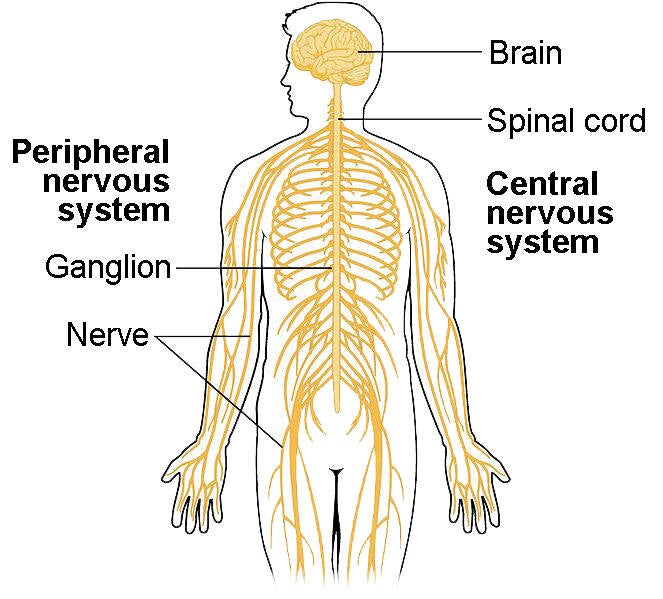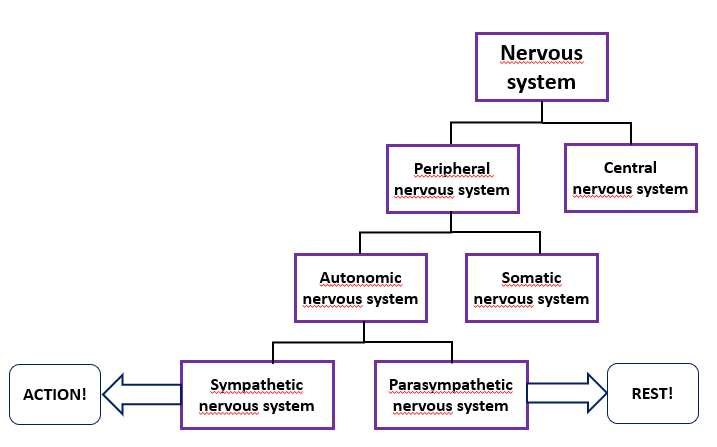The nervous system
The nervous system receives information from the environment, for example light, sound, temperature, touch. It ensures that the body can respond to this, for example by activating muscles, glands and hormones.
An example of how the nervous system responds to heat and activates a muscle is touching a hot stove. Your nervous system senses that the plate is too hot, so you withdraw your hand as quickly as possible. You feel pain and you learn from the mistake of just touching a stove without checking whether it was on or not. You will probably be more careful in the future and check this first.
The nervous system is a large system and is spread throughout the body (see also Figure 1). Roughly speaking, it consists of two parts: the central nervous system and the peripheral nervous system. It is important to know that the central and peripheral nervous systems are connected and work together.
- The central nervous system consists of the brain and spinal cord. The brain is located in the skull and consists of different brain areas.
There are also 12 cranial nerves that run from the brain. The spinal cord is located in the spinal column and runs from the neck to the lower back. - The peripheral nervous system consists of nerve pathways that run throughout the body (yellow in the image below). Furthermore, it consists of
gathering points where the nerve pathways come together. These are also called ganglions.

Figure 1: Image from https://commons.wikimedia.org/w/index.php?curid=30147907
The Peripheral Nervous System
The peripheral nervous system is further divided into different parts (see also figure 2). Here we will go into more detail about what the different components are concerned with.
Somatic nervous system
The somatic nervous system is concerned with tasks that we perform consciously and/or voluntarily. Below are a few examples of tasks associated with the somatic nervous system:
Passing information from the senses (sight, smell, taste and touch) to the brain. Here are sensory nerves
involved in.
Consciously controlling the muscles. For example, when you want to wave at someone or pick up a glass of water. Here are
motor nerves involved.
Autonomic nervous system
The autonomic nervous system controls our organs. We are usually not aware of this. The influence we have on the autonomic nervous system is limited. It happens 'outside of us'. Examples of actions of the autonomic nervous system:
- Regulating your heart rate, blood pressure and body temperature
- Regulating your digestion
- Regulating the release of sweat
The autonomic nervous system can be further divided into a sympathetic and a parasympathetic part.
- The sympathetic nervous system: ACTION!
It is the nervous system that ensures that you can take action. That you can make an effort, but that you are also active when stressed.
It can be considered as an accelerator.
- The parasympathetic nervous system: REST!
The nervous system that ensures the relaxation and recovery of the body. It can be considered as the brake.
The two systems keep each other in balance: when one is active, the other is at rest and vice versa.
Read more about how to calm your nervous system.
The nervous system and brain injury
Now that we understand that the nervous system is involved in so many tasks, it is not surprising that brain injuries can have so many different consequences.
This entire website is intended to give you the best possible information about this. For example, we provide information about the consequences of damage to certain brain areas.
Often most attention is paid to the injury as a result of damage to the brain itself (which is part of the central nervous system). But the peripheral nervous system also plays an important role in brain injury and its possible consequences.
An example of this is the development of an imbalance between the sympathetic and parasympathetic systems.
An imbalance between these two systems can lead to complaints such as experiencing more stress and sleep problems.

Figure 2: overview of the different parts of the nervous system. The sympathetic and parasympathetic nervous systems are both part of the autonomic nervous system
The explanation about the 12 cranial nerves and what consequences there are if there is damage to a cranial nerve is explained on the
neurological examination page.
More information about the nervous system
More information about neurotransmitters
Resources
Hersenletsel uitleg | Hersenletsel-uitleg.nl. (2018). van https://www.hersenletsel-uitleg.nl/
Karemaker JM. An introduction into autonomic nervous function. Physiol Meas. 2017 May;38(5):R89-R118. [PubMed]
Kuks, J. B. M., Snoek, J. W., Oosterhuis, H. G. J. H., & Fock, J. M. (2003). Klinische neurologie (15e ed.). Houten, Nederland: Bohn Stafleu van Loghum.
Neurologie, 7e druk, Bohn Stafleu van Loghum, ISBN 97 8903 681 1880 medewerking van dr. A. Hijdra, prof. dr. P. Koudstaal, prof.dr. R.A.C Roos, mei 2017
Sternini C. Organization of the peripheral nervous system: autonomic and sensory ganglia. J Investig Dermatol Symp Proc. 1997 Aug;2(1):1-7. [PubMed]2.